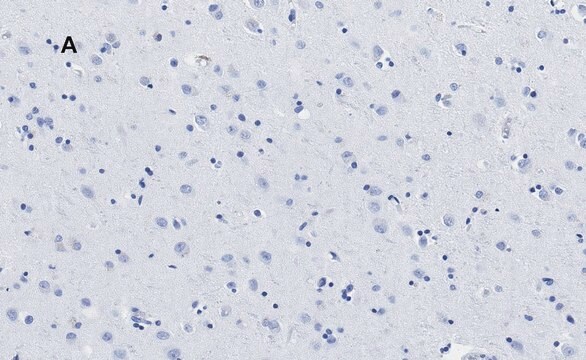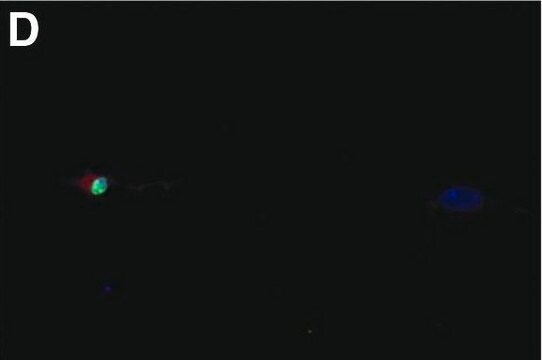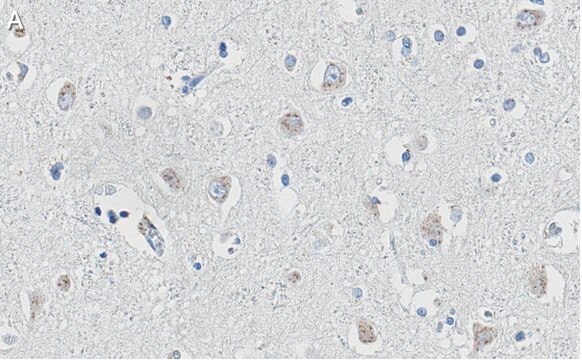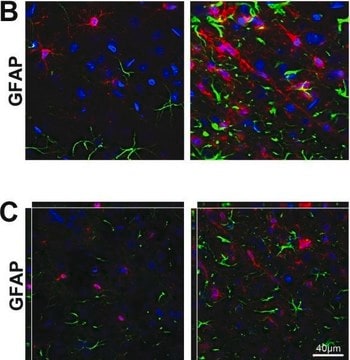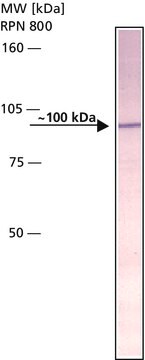MAB343
Anti-APP Antibody, APP 643-695 CT fragment, clone 2.F2.19B4
ascites fluid, clone 2.F2.19B4, Chemicon®
Synonym(e):
APP, Jonas clone
About This Item
WB
western blot: suitable
Empfohlene Produkte
Biologische Quelle
mouse
Qualitätsniveau
Antikörperform
ascites fluid
Klon
2.F2.19B4, monoclonal
Speziesreaktivität
rat, human
Hersteller/Markenname
Chemicon®
Methode(n)
immunohistochemistry: suitable (paraffin)
western blot: suitable
Isotyp
IgG1
NCBI-Hinterlegungsnummer
UniProt-Hinterlegungsnummer
Versandbedingung
dry ice
Posttranslationale Modifikation Target
unmodified
Angaben zum Gen
human ... APP(351)
Spezifität
Immunogen
Anwendung
Neurowissenschaft
Neurodegenerative Krankheiten
Western blot: 10 μg/mL
Optimal working dilutions must be determined by end user.
APPLICATION NOTES FOR MAB343
IMMUNOHISTOCHEMISTRY
1) Prepare paraformaldehyde-fixed paraffin sections. Wash twice for 5 min in xylene to deparaffinize. Wash sections for 5 min in a descending series of alcohol solutions (100%, 96%, 90%, 80%, 70%, 50%, 30%).
2) Wash sections 3 times in distilled water.
3) Wash in TBS (50 mM Tris-HCl, 150 mM NaCl, pH 7.6). To block endogenous peroxidase wash with methanol containing 0.6% H2O2 (v/v) and 10 % horse serum (v/v) for 5 min at room temperature.
4) Wash sections for 5 min in TBS.
5) Incubate sections with MAB343 (diluted in TBS containing 10% horse serum (v/v)) overnight at +4°C or for 2 hours at 37°C in a humid chamber.
6) Wash sections 3 times in TBS for 5 min..
7) Detect with standard secondary antibody detection system (PAP, ABC, etc.).
8) Wash sections in TBS.
9) Embed sections and examine.
Physikalische Form
Lagerung und Haltbarkeit
Hinweis zur Analyse
Brain
Sonstige Hinweise
Rechtliche Hinweise
Haftungsausschluss
Empfehlung
Lagerklassenschlüssel
10 - Combustible liquids
WGK
WGK 1
Flammpunkt (°F)
Not applicable
Flammpunkt (°C)
Not applicable
Analysenzertifikate (COA)
Suchen Sie nach Analysenzertifikate (COA), indem Sie die Lot-/Chargennummer des Produkts eingeben. Lot- und Chargennummern sind auf dem Produktetikett hinter den Wörtern ‘Lot’ oder ‘Batch’ (Lot oder Charge) zu finden.
Besitzen Sie dieses Produkt bereits?
In der Dokumentenbibliothek finden Sie die Dokumentation zu den Produkten, die Sie kürzlich erworben haben.
Unser Team von Wissenschaftlern verfügt über Erfahrung in allen Forschungsbereichen einschließlich Life Science, Materialwissenschaften, chemischer Synthese, Chromatographie, Analytik und vielen mehr..
Setzen Sie sich mit dem technischen Dienst in Verbindung.

